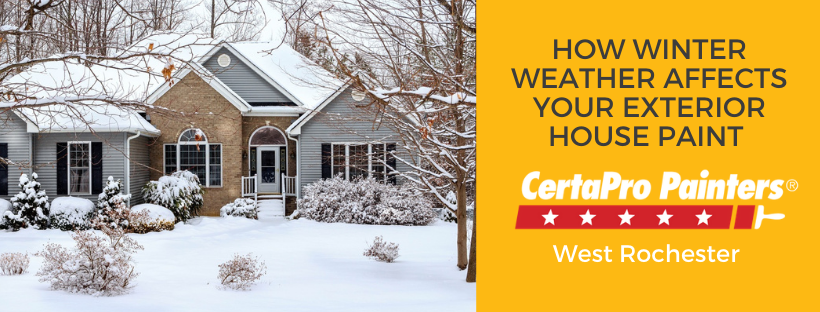
How winter weather affects exterior house paint
Posted on November 29, 2020
Let’s face it old man winter is tough in Rochester. It’s tough on roads, it’s tough on cars, it’s tough on roofs and it’s also tough on your exterior house paint. What most people don’t know is that it causes problems that can come from the outside weather in, but also from the inside of your house out.
Some of the problems your exterior can face from direct exposure to winter weather include:
Penetration of moisture that turns to ice: When water gets into tiny cracks it expands when it freezes. The more times this cycle continues the larger the areas of expansion develops. When that area is between the paint and your siding the ice is literally prying the paint off your house.
Gutter overflow that freezes: Water forming between the gutters and the fascia boards behind the gutters forms ice blocks that keep your paint in a constant state of moisture exposure. This leads to rot that is often difficult to detect but can be bad enough to let water into the interior of your home. If you have ever had a water leak in your home you know they are very hard to isolate and a little amount of water can cause a lot of problems.
Basically anywhere you get ice buildup along the roofline, gutters or eaves can be a problem when it melts and runs down the paint. Being constantly covered in water for extended periods of time pushes exterior paint to its limits. Don’t forget snow drifts up against the house, if it’s going to take days to completely melt you are going to want to carefully clear most of it away but don’t impact the house doing it. get close enough so that what’s left will melt away quickly.
Plants and branches rubbing against cold paint: Like most things paint becomes brittle with extreme cold. When wind forces branches and plants to rub against the paint it tends to scratch grooves into it much more easily. In any small opening, water can find its way in and problems begin.
Whenever water finds its way into your house and into a warm area the next problem you develop is mold. Nobody wants mold.
So can’t you paint at least a little touch-up or two during the winter? The answer is likely no. most paints need sustained temperatures at least in the mid-’40s to adhere and this assumes you would be painting a prepared, dry surface. You can’t slap paint on like a bandaid, it will peel right off without the correct preparation. If you have touch-up paint you also need to store it somewhere that never freezes. Freezing paint in a can basically ruins it.

Problems you can have on the interior during winter that affect your exterior paint include:
With everyone spending a lot of time indoors a home can have a high humidity level, especially as compared to the dry conditions outside in the cold. Moisture from laundry, cooking, and showers can build up and as they are drawn from damp areas to dry by natural wicking action it can pass through sheetrock, insulation, exterior wall cladding, and find its way ultimately between your siding and your paint. Today most houses are built with a moisture barrier material like Tyvek that prevents the problem but many older homes lack moisture barriers.
Interior moisture can also find its way into attics and either pass outside through attic vents or out through the roof cladding. This causes less immediate damage because roofing materials are notably tougher than paint.
So what do you do? Try not to let your house become a sauna. The same high level of moisture in the air that makes some heating more effective is also the moisture that will try getting through your exterior paint. A dehumidifier is a good idea if you have a large number of people under one roof taking showers, boiling water on the stove, and running the washing machine. You don’t have to have the level so low you keep getting zapped every time you touch a light switch but it should be at a level similar to what you might have in late summer or spring.
Make sure to run kitchen fans and bathroom fans that exhaust air to the outside. Also, make sure your dryer vent hose is firmly connected and sealed and you will be removing moisture from its source. Focussing on removing moisture at its source while it’s being created is a good idea both for paint preservation and for mold prevention.
When the weather finally turns and winter is behind you, schedule a careful walk-around inspection of your home’s exterior. Look at the paint around window and door frames, along the lower portion of your house, gutter areas, and eaves. See if you have any plants or tree branches that are in constant contact with the house or in contact with a very light breeze. these need to be trimmed back at some point before the next winter.
If you find that your exterior house paint has seen its last winter and it’s time for a fresh coat, or you plan on doing it in the spring anyway contact CertaPro Painters® of West Rochester, NY at 585-200-5007 or schedule an estimate online using our appointment form. We can block off the time of your choice now so that you get a jump on spring and have your project done at the time of maximum convenience for you.





